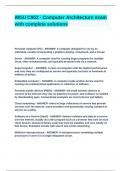WGU C952 - Computer Architecture exam
with complete solutions
Personal computer (PC) - ANSWER- A computer designed for use by an
individual, usually incorporating a graphics display, a keyboard, and a mouse.
Server - ANSWER- A computer used for running larger programs for multiple
users, often simultaneously, and typically accessed only via a network.
Supercomputer: - ANSWER- A class of computers with the highest performance
and cost; they are configured as servers and typically cost tens to hundreds of
millions of dollars.
Embedded computer: - ANSWER- A computer inside another device used for
running one predetermined application or collection of software.
Personal mobile devices (PMDs) - ANSWER- are small wireless devices to
connect to the Internet; they rely on batteries for power, and software is installed
by downloading apps. Conventional examples are smart phones and tablets.
Cloud computing - ANSWER- refers to large collections of servers that provide
services over the Internet; some providers rent dynamically varying numbers of
servers as a utility.
Software as a Service (SaaS) - ANSWER- delivers software and data as a service
over the Internet, usually via a thin program such as a browser that runs on local
client devices, instead of binary code that must be installed, and runs wholly on
that device. Examples include web search and social networking.
Multicore microprocessor - ANSWER- A microprocessor containing multiple
processors ("cores") in a single integrated circuit.
,Acronym - ANSWER- A word constructed by taking the initial letters of a string of
words. For example: RAM is an acronym for Random Access Memory, and CPU is
an acronym for Central Processing Unit.
Terabyte (TB): - ANSWER- Originally 1,099,511,627,776 (240) bytes, although
communications and secondary storage systems developers started using the
term to mean 1,000,000,000,000 (1012) bytes. To reduce confusion, we now use
the term tebibyte (TiB) for 240 bytes, defining terabyte (TB) to mean 1012 bytes.
The figure below shows the full range of decimal and binary values and names.
Systems software: - ANSWER- Software that provides services that are
commonly useful, including operating systems, compilers, loaders, and
assemblers.
Operating system - ANSWER- Supervising program that manages the resources
of a computer for the benefit of the programs that run on that computer.
Compiler - ANSWER- A program that translates high-level language statements
into assembly language statements.
Binary digit - ANSWER- Also called a bit. One of the two numbers in base 2 (0 or
1) that are the components of information.
Instruction - ANSWER- A command that computer hardware understands and
obeys
Assembler - ANSWER- A program that translates a symbolic version of
instructions into the binary version.
Assembly language - ANSWER- A symbolic representation of machine
instructions.
Machine language - ANSWER- A binary representation of machine instructions
High-level programming language - ANSWER- A portable language such as C, C+
+, Java, or Visual Basic that is composed of words and algebraic notation that
can be translated by a compiler into assembly language.
Input device - ANSWER- A mechanism through which the computer is fed
information, such as a keyboard.
, Output device - ANSWER- A mechanism that conveys the result of a computation
to a user, such as a display, or to another computer
Liquid crystal display: - ANSWER- A display technology using a thin layer of
liquid polymers that can be used to transmit or block light according to whether a
charge is applied.
Active matrix display - ANSWER- A liquid crystal display using a transistor to
control the transmission of light at each individual pixel.
Pixel - ANSWER- The smallest individual picture element. Screens are composed
of hundreds of thousands to millions of pixels, organized in a matrix.
Integrated circuit - ANSWER- Also called a chip. A device combining dozens to
millions of transistors.
Central processor unit (CPU) - ANSWER- Also called processor. The active part of
the computer, which contains the datapath and control and which adds numbers,
tests numbers, signals I/O devices to activate, and so on.
Datapath - ANSWER- The component of the processor that performs arithmetic
operations.
Control - ANSWER- The component of the processor that commands the
datapath, memory, and I/O devices according to the instructions of the program.
Memory - ANSWER- The storage area in which programs are kept when they are
running and that contains the data needed by the running programs.
Dynamic random access memory (DRAM) - ANSWER- Memory built as an
integrated circuit; it provides random access to any location. Access times are 50
nanoseconds and cost per gigabyte in 2012 was $5 to $10.
Cache memory - ANSWER- A small, fast memory that acts as a buffer for a
slower, larger memory.
Static random access memory (SRAM): - ANSWER- Also memory built as an
integrated circuit, but faster and less dense than DRAM.
Instruction set architecture - ANSWER- Also called architecture. An abstract
interface between the hardware and the lowest-level software that encompasses




